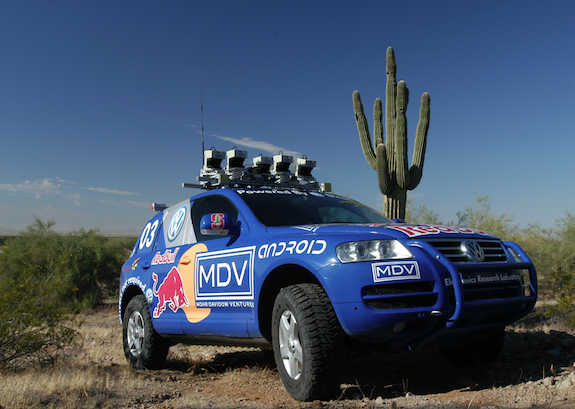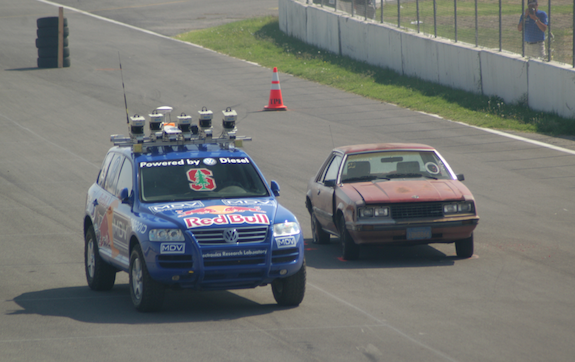Robot Car Stanley is on the Move
The driverless car that made history navigating 132 miles in the desert heads across the Mall to the Air and Space Museum for a new exhibit
![]()

Stanford Racing Team’s robotic vehicle Stanley revolutionized driverless car technology. Courtesy Stanford Racing Team
“It will not be enough for a car to have a strong body,” said Stanford University computer science professor Sebastian Thrun. “It will also need a strong mind.”
With those words on May 18, 2005, the robotic, driverless car known as Stanley was introduced to the world. Stanley went on to make history when it won the 2005 Defense Advanced Research Projects Agency Grand Challenge and successfully navigated across 132 miles without a driver. Now Stanley will make yet another historic journey; traveling across the National Mall.
As part of the upcoming exhibit “Time and Navigation: The Untold Story of Getting from Here to There” at the Air and Space Museum, the car will be leaving its home at the American History Museum to move about seven city blocks to its temporary home. For this trip, however, Stanley won’t be responsible for the directions. Instead, Stanley will hitch a ride on a flatbed truck to go the distance.

The other cars were no match for Stanley in the 2005 Grand Challenge. Courtesy Stanford Racing Team
Google is now paving the way for the commercial launch of its driverless car and three states—Nevada, California andFlorida—have already authorized their use (the District of Columbia is considering it). But, in 2005 when Stanley took to the open desert, the event was an unprecedented technological leap forward. At DARPA’s 2004 competition, no car made it more than eight miles on the course, not inspiring a great deal of confidence. But then Stanford decided to get involved, under the direction of Thrun, who is now leading the development of Google’s autonomous car. Thrun’s expertise in artificial intelligence was matched by Mike Montemerlo’s software savvy. Meanwhile, the senior research engineer at the Volkswagen of America Electronics Research Laboratory Sven Strohband helped the team turn a Volkswagen Touareg into a completely different kind of automobile.
Equipped with five roof-mounted Light Detection and Ranging (LIDAR) units and two GPS antennas, the car was able to differentiate between objects and shadows as well as position itself geographically–all while maintaining a 34.9 highway mpg. Stanley completed the Challenge in just under seven hours, securing a $2 million grand prize. The car first came to the American History Museum in 2006.
Meanwhile, Thrun continues to work on artificial intelligence as the founder of Google X, a secretive laboratory that has produced augmented reality glasses, the driverless car and smarter image recognition software (beginning with, what else, cats).
Though Thrun’s work is certainly foundational for many technologies of the future, the history of navigation and way-finding goes way back.
The Air and Space Museum’s “Time and Navigation: The Untold Story of Getting from Here to There” will incorporate Stanley as just one of 144 artifacts that represent the long tradition of navigation, from the sea to outer space. Though the phenomena now seems as commonplace as smartphones, finding your way once meant elaborate calculations that coordinated time and space. From 19th century exploration to aviator Wiley Post’s around-the-world flights to cars without drivers, the exhibit shows how timekeeping and navigation practices helped revolutionize daily life.
Curator Carlene Stephens writes, “Innovations that combine GPS coordinates with portable computing power, communications, map data and electronic images have led to an explosion of new civilian applications.” While Stanley represents new applications, Stephens says the technology also raises new questions. In an email, Stephens writes about the development of the driverless car, “They are technically more possible than ever before, but the social questions remain. Are they safe? Do people want to give up driving?”
Car enthusiasts can follow the action on Twitter with the hashtag #GoStanley. Stanley is scheduled to arrive at the Air and Space Museum’s west end at 8:30 a.m. on Wednesday, October 24 (weather permitting).
“Time and Navigation: The Untold Story of Getting from Here to There” will open spring 2013.
/https://tf-cmsv2-smithsonianmag-media.s3.amazonaws.com/accounts/headshot/Leah-Binkovitz-240.jpg)
/https://tf-cmsv2-smithsonianmag-media.s3.amazonaws.com/accounts/headshot/Leah-Binkovitz-240.jpg)